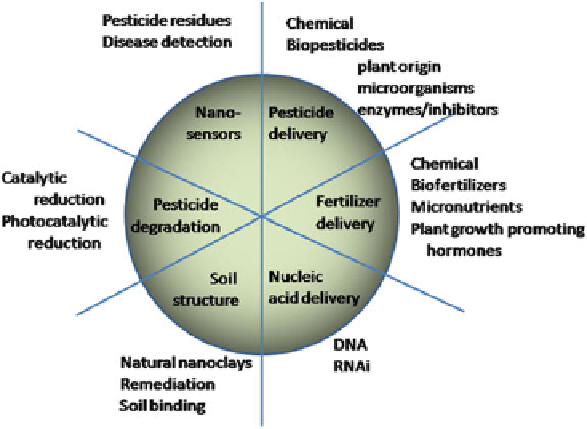Agriculture Reference
In-Depth Information
Fig. 5.3 Applications of nano-biotechnology in plant protection and nutrition (Ghormade
et al.
2011
). Reproduced by permission of Elsevier
characteristics of some nanoparticles: a large surface to volume ratio, chemically
alterable physical properties, changes in the chemical and physical properties with
respect to size and shape, and enhanced or delayed particle aggregation depending
upon the type of surface modification type, among others.
5.2 Goals and Advantages of a Controlled Release System
Due to many advantages over traditional agrochemical application methods, several
authors have used the concepts of controlled release (CR) systems (Aouada
et al.
2009
,
2010
; Dubey et al.
2011
; Bortolin et al.
2012
; Ghazali et al.
2013
;
Carson et al.
2014
; Cartmill et al.
2014
; Wanyika
2014
) to propose alternatives to
combat environmental pollution (Chuxiang et al.
2014
). The main objective of CR
systems is to allow for the controlled delivery of an active compound over time and
maintaining the activity through a desired period in the soil, resulting in the
reductions of the quantities of the agrochemical used, manpower, and energy or
combustives necessary to operate the application devices as well as in the increase
of safety to humans who apply the chemicals (Aouada et al.
2011
; Chevillard
et al.
2012
). Coupled with this objective, the use of nanotechnology has become
an important strategy in environmental remediation efforts by providing solutions
to environmental cleanup challenges (El-Temsah and Joner
2013
). In addition,
Sope˜a et al. (
2009
) listed some advantages of CR in relation to conventional
methods: (1) to reduce herbicide loss due to lixiviation, volatilization, drift, and
degradation in soils; (2) to reduce phytotoxicity; and (3) to facilitate herbicide
management and safer applications, reducing toxicity in humans. In the case of the

